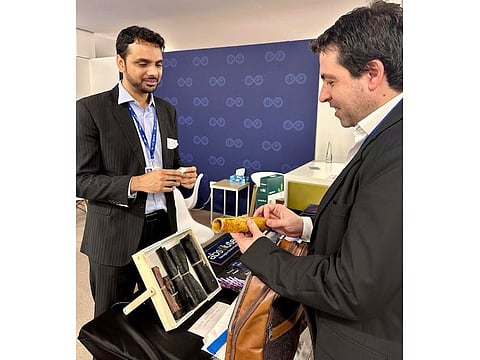Bioscience company Absolute unveils Bioleather at COP28
The introduction of Bioleather aligns with the rapidly growing biomaterials market

Bioscience company, Absolute, recently announced a significant breakthrough in sustainable materials at COP28 - the world's biggest climate change conference. Absolute introduced successful prototypes of Bioleather, developed at the company’s R&D core - Xenesis.
The production of animal leather significantly contributes to greenhouse gas emissions, with livestock being one of the largest contributors globally, accounting for 18% of anthropogenic greenhouse gases each year. The tanning process in leather manufacturing is another major environmental issue, with one square metre of leather hide producing as much as 16,500 litres of wastewater containing harmful chemicals like chromium, posing serious risks to human health and ecosystems.
Recognizing the urgent need to combat these environmental impacts, Absolute's R&D core Xenesis is on a mission to introduce sustainable alternatives for traditional leather. While there are existing sustainable materials, they have not successfully been able to mimic the properties of animal leather.
"That's where biotechnology comes in, says Dr. Prashant Khare, Director of R&D at Xenesis. Today, with the tools we have, we can create anything the exact same way that nature creates it. While these tools are complex and some require really out of the box thinking, the simple approach of understanding how nature takes decisions is the key, he adds."
Biotechnology offers a much-needed solution to current challenges in the sustainable materials space. The prototypes made at Xenesis deploy extremophiles, identified as part of its proprietary Nature Intelligence Platform (NIP), to create bio-leather from agricultural waste. NIP is one of the world’s largest libraries of novel microbes, biomolecules and enzymes found in nature.
Agam Khare, Founder & CEO, Absolute said "It is a privilege to represent the work of our brilliant scientists at COP28, surrounded by innovators who share our hefty goal of fighting the global climate crisis."
The introduction of Bioleather aligns with the rapidly growing biomaterials market, which was valued at $155.05 billion in 2022 and is expected to expand at a CAGR of 15.52% from 2023 to 2030 and Bioleather represents a significant portion of this growth.
Biotechnology holds the promise of a world where our material needs align seamlessly with our environmental responsibilities. The good news lies in the fact that this transition towards biotech enabled materials has already begun in different parts of the world.
Sign up for the Daily Briefing
Get the latest news and updates straight to your inbox



